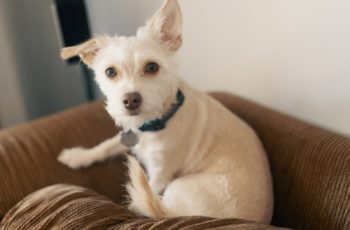Last updated:
Have you ever seen two dogs wrestling and thought: are they playing or fighting? Fighting is a normal behavior and part of dog play. For puppies, it begins with their littermates. From the moment they open their eyes, until they go to their homes, puppies spend most of their time wrestling with each other.
During that period of social development, puppies learn bite inhibition, and proper manners, and use play fighting as exercise and socialization. Here is how to determine the difference between dog play fighting and an actual fight and when to step in.
Why Do Dogs Play Fight?
Play fighting is a natural behavior, rooted deeply in canine’s ancestral instincts and social dynamics. During playful fighting, dogs shape their social skills, learn how to interact with fellow canines in a positive and non-threatening manner and establish pack order.
Play fighting is also a form of socialization, exercise, and mental stimulation for canines. It provides a great outlet to burn off energy while assessing their opponent’s moves. Play fighting keeps dogs engaged, and helps them learn the body language of other canines.

Should Dogs Play Fight?
Yes, it is fine for dogs to play fight as long as the play remains healthy, friendly, and non-aggressive. This natural and instinctive behavior serves important purposes in a dog’s development and well-being.
Yet, as a responsible dog owner, you should monitor the play and make sure it remains safe and that dogs follow certain conditions. Pay attention to the following factors:
- All dogs willingly participate and enjoy the play.
- Dogs should show relaxed body language and take turns chasing and being chased.
- There are frequent breaks for self-control.
- The play doesn’t escalate into real aggression.
- Dogs engaging in play fighting should be similar in size, age, and energy levels.
How to Tell if Dogs are Playing or Fighting
Let’s talk now about how to tell when dogs are playing. Dog owners should always know the difference between play fighting and real aggression.
Play Fighting
Watch physical cues and signs, like dogs having a big, silly, and open-mouthed grin. Your dog’s movements should be bouncy and can show exaggerated growling.
But the biggest tell is the play bow, a body language posture dogs use. In the play bow, dogs put their front down, while their back is in the air. They use it to initiate play, and sometimes even slap their front legs down on the ground repeatedly.
Play growling is friendly, loud, and sometimes, exaggerated. The noise might sound scarier than it is.
Dogs make themselves vulnerable voluntarily by falling down and exposing their bellies to another dog. Playing dogs allow themselves to be caught while playing chase, and take turns chasing each other.
When dogs play, they keep circling back for more. Dogs that end up losing, will end up on their backs to continue the play.
Real Fighting
Now let’s take a look at some common signs dogs are not playing and they are being aggressive. Dog play and dog-aggressive fighting can look similar, but they are different.
For starters, their body looks upset when threatened by another dog. Your dog’s entire body becomes stiff, and you can notice their hackles are raised. It is harder to spot in dogs with long hair, but you can still see the hair on the upper back rising.
Growls are different and sound like warning growls. Dogs close their mouths and curl their lips. Instead of moving to each other and coming back for more play, they try to get away from one another. They are not happy and bouncy, and one of the dogs might tuck its tail.
Dog owners have a few seconds to react before dogs end up fighting. Usually, the fight is a short encounter, and the loser will not stick around.

Difference Between Play Fight and Play Aggression
Let’s break down the differences, making it easier for pet parents to understand them.
Body Language
In play fights, dogs have a relaxed body language and display playful signals. The most obvious one is the playful bow, and their tails wag in a loose and neutral position.
During aggression, dogs have tense and stiff bodies, with their tails held high. They appear rigid, with their ears pinned back.
Facial Expression
Dogs that play have relaxed mouths and appear as if they are smiling. They can gently mouth each other without causing harm.
Aggressive dogs have tight and tense mouths, with lips curled back and showing their teeth in a snarl.
Bite Intensity
During play fights, bites are gentle as dogs learn bite inhibition. They do not try to cause pain. And if one dog bites too hard, the other one will yelp and the play pauses for a few seconds. After that, it continues with gentler bites.
If dogs fight, they have no self-control, bites are hard and quick with the intention to cause harm.
See also

Focus
Playful dogs take frequent breaks and have short bursts of energy. Their intention is to have fun.
Aggressive dogs are focused on the target, trying to establish dominance or defend their territory.

Responding to Feedback
Dogs that play can stop when their owner calls or one of the dogs shows discomfort. They can take a short break and resume playing after.
In aggressive situations, dogs do not respond to feedback. Owners have a hard time controlling their dogs as they might not respond to commands and cues. They do not back down after a yelp or a warning.
Roles
During playing fights, dogs switch roles. First one dog chases, and then the other dog chases. The idea is to take turns being dominant and submissive.
In an aggressive encounter, both dogs try to assert their dominance. There is no role-switching.
Should I Break Up a Fight?
You should never try to separate dogs in the middle of the fight by grabbing the collar or using any part of your body. This is because they are in high “fight drive” and are not thinking clearly when they’re fighting. If you or another person tries to grab them, they will most likely bite without thinking about who or what they are biting.
The safe way to break a fight is to make a loud noise that will distract the dogs. Another option is an object that will separate the dogs.
If the fight continues, and distraction doesn’t work, the last option is the wheelbarrow method. Both owners grab the back legs of their respective dogs and pull them away from each other.

Final Words
The best way to prevent a fight is to notice the signs and tell the difference between play fighting and aggressive behavior.
Pet parents should monitor vocalization, observe body language, watch play signals like the play bow and relaxed tail wagging, and pay attention to whether dogs take natural breaks and change roles.You should also be aware of your dog’s natural level of aggression. If they are naturally aggressive, avoid walking them near other dogs or dog parks. You can always change the direction of the walk and stop dogs from getting too close to avoid a fight from the start.


